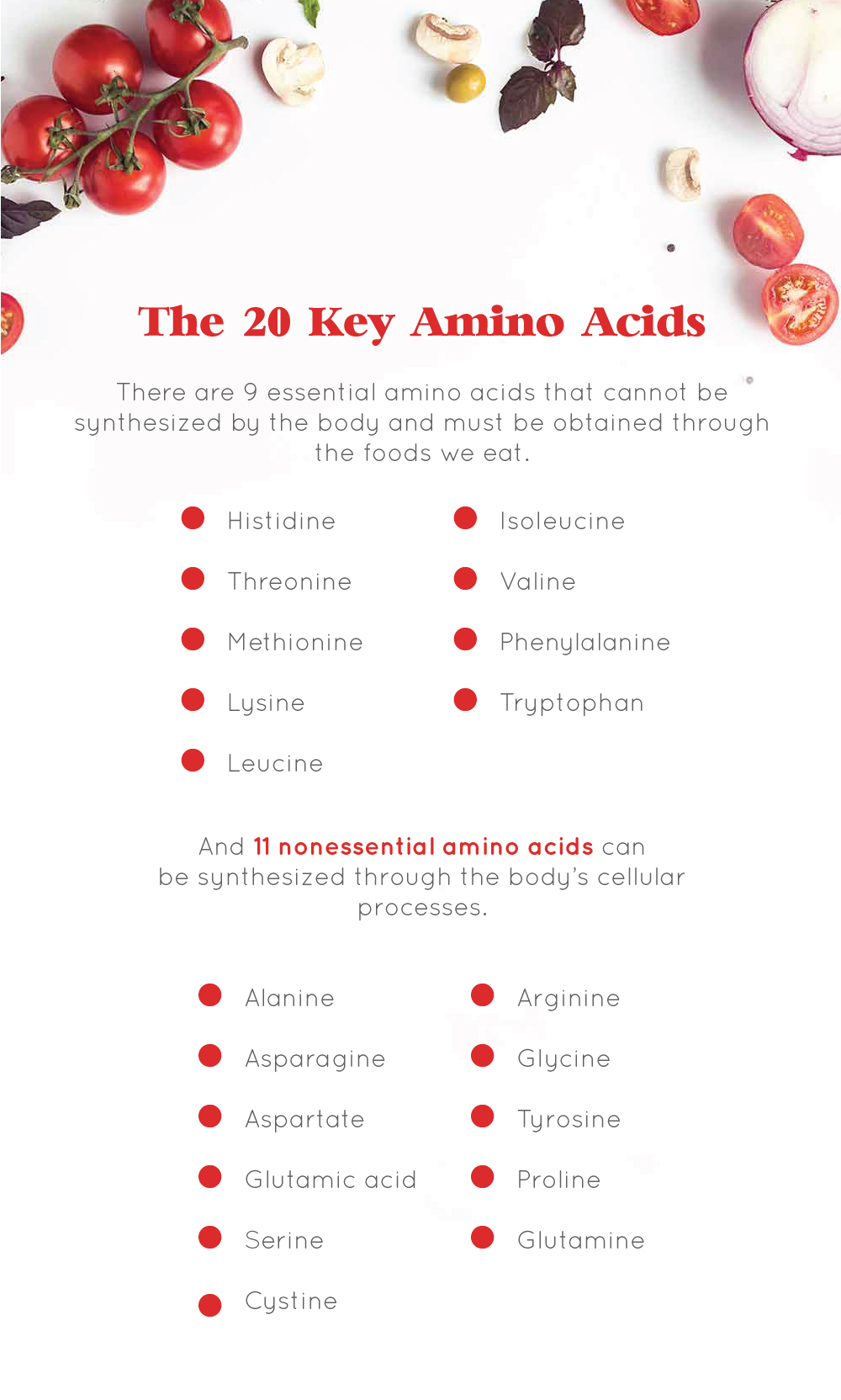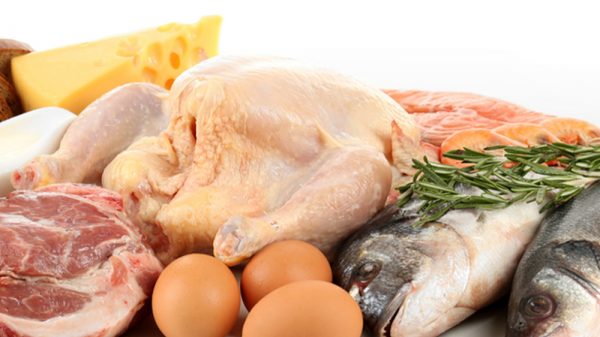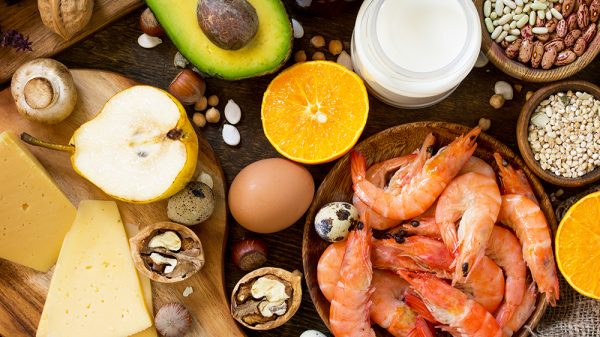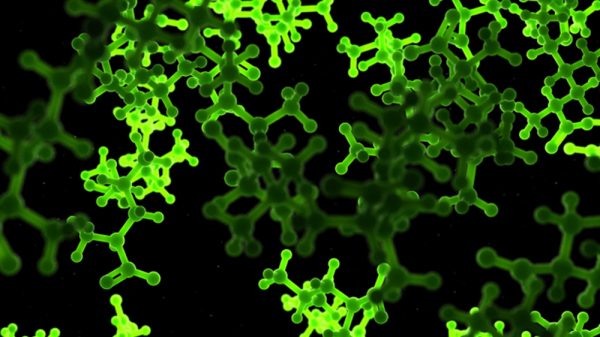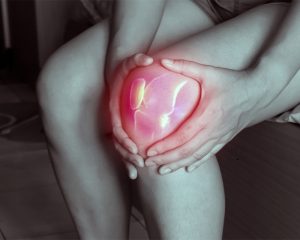Amino acids are organic compounds that are often referred to as the building blocks of protein. Our body relies on amino acids to execute nearly all physiological processes- we need amino acids almost as much as we need oxygen! Because of the versatility of amino acid functions, amino acid deficiency signs and symptoms span all organ systems in the body. Here we give you the full download on the functions of amino acids and symptoms of deficiency.
The 20 Key Amino Acids
There are 20 main amino acids that are critical for human biological function and protein synthesis. These amino acids are traditionally grouped into two categories: essential and nonessential. Keep in mind that the terms “essential” and “nonessential” describe the necessity to include these amino acids in the foods we eat.
- Essential: These amino acids cannot be synthesized by the body and must be obtained through the foods we eat. The nine essential amino acids are histidine, threonine, methionine, lysine, leucine, isoleucine, valine, phenylalanine, and tryptophan.
- Nonessential: These amino acids can be synthesized through the body’s cellular processes, and include alanine, asparagine, aspartate, glutamic acid, serine, cystine, arginine, glycine, tyrosine, proline, and glutamine.
Some of the nonessential amino acids are described as conditionally essential. This means that under normal circumstances, the body is able to synthesize adequate amounts of these amino acids. However, when the body is under stress – for example, during periods of injury or illness – the body requires more of these amino acids than it can make on its own. So, increasing dietary intake is required during these times.
There is also a growing body of evidence suggesting that for optimal functioning and performance, humans actually do need a certain dietary intake of amino acids that have been traditionally classified as nutritionally nonessential.
How Amino Acids Make Proteins
Amino acids participate in so many biological processes because of their chemical structures and properties. There are certain characteristics that amino acids have in common. All contain a carbon atom that is bonded to an amine group (a nitrogen atom bonded to two hydrogen atoms) and a carboxyl group (a carbon atom bonded to an oxygen atom and an oxygen-hydrogen group).
The side chain, or R group, is the part of an amino acid that makes it unique in structure and function. For example, the side chains of leucine and isoleucine contain only carbon and hydrogen atoms, making these amino acids hydrophobic (meaning that they are not attracted to water molecules). Other amino acids, like lysine, have R groups containing nitrogen, making them hydrophilic (meaning they are attracted to water molecules). The properties of R groups have implications for the final protein structure and function.
In the protein-making process, amino acids are strung together to create a polypeptide chain. Depending on the R groups present in the amino acids, polypeptide chains will twist themselves into specific shapes to create a protein. For example, if the R groups are hydrophobic, the amino acid chains will orient so that the R groups interact with each other. If R groups are hydrophilic, the chains will orient so that the R groups are on the outside of the protein and interacting with aqueous surroundings. The vast array of proteins that amino acids can build can be attributed to the variety of chemical properties present in R groups.
Functions of Essential Amino Acids
Understanding the roles of different amino acids in the body is crucial to understanding the symptoms associated with deficiency. The symptoms are just as varied as the functions!
- Histidine: Histidine is crucial to the structure of the blood protein hemoglobin and exhibits antioxidant properties. Histidine is also responsible for regulating gut function and immune response to allergens, especially in the skin.
- Threonine: Threonine plays a role in gut health, particularly in the intestine, and is needed for the synthesis of glycine.
- Methionine: Methionine is involved in synthesizing cystine and taurine, which serve as antioxidants, regulate cellular energy, ensure proper organ growth, and support the health of muscles, including the heart.
- Lysine: Lysine regulates immune function by fighting viral infections. This amino acid also serves as a building block of collagen and connective tissue and is a critical component of wound healing.
- Leucine, isoleucine, and valine: These three amino acids are grouped together as branched-chain amino acids (BCAAs) and have similar functions in the body. BCAAs are critical for muscle growth, immune system function, and glutamine and alanine synthesis.
- Phenylalanine: Phenylalanine is vital for healthy central nervous system function. Phenylalanine is involved in tyrosine synthesis and the subsequent production of neurotransmitters dopamine, epinephrine, and norepinephrine.
- Tryptophan: Tryptophan exerts anti-inflammatory properties and supports immune health. Tryptophan is involved in the synthesis of serotonin and melatonin.
Essential Amino Acid Deficiency Symptoms
Your symptoms depend on the functions of the individual amino acids you are missing. If you are deficient in histidine, you may notice skin irritation or rashes. Deficiencies in phenylalanine or tryptophan may result in brain fog, anxiety, and irregular sleep schedule. If you are missing threonine, you may experience digestive issues. Deficits in BCAAs and lysine may exhibit as slow recovery after strength training, muscle soreness, and muscle loss. Low levels of methionine can compromise liver function.
A general deficiency of essential amino acids can also cause you to contract viral infections more easily due to inefficient immune function. Another serious sign of low essential amino acids is impaired growth due to inhibited growth hormone, which is usually a result of a low protein diet.
Functions of Nonessential Amino Acids
Let’s take a look at the roles of specific nonessential amino acids in your body. Just as a reminder, the term “nonessential” only means that you’re body is able to produce these amino acids internally and doesn’t always require nutritional sources. Nonessential amino acids are just as critical to life as essential amino acids are.
Nonessential Amino Acids
- Alanine: Alanine supports liver health by clearing out damaged cells. Alanine also facilitates gluconeogenesis in the liver, which is the production of glucose during periods of limited carbohydrate availability.
- Asparagine: Asparagine supports cellular metabolic processes, healthy immune and nervous system response, and manages gene expression.
- Aspartate: Aspartate is crucial for DNA synthesis and increasing NMDA receptor activity in the brain.
- Glutamic acid: Glutamic acid plays an important role in facilitating the urea cycle and increasing NMDA receptor activity.
- Serine: Serine is critical for neurological development, NMDA receptor activation, and synthesis of DNA, cystine, and tryptophan.
- Cystine: Cystine fortifies the structure of proteins and facilitates communication between cells.
- Arginine: Arginine plays a critical role in regulating hormone levels, fertility, and immune response. Arginine also has an important role in preventing fatty liver disease and detoxifying ammonia.
- Glycine: Glycine regulates cell membrane calcium channels and operates as a neurotransmitter in the central nervous system.
- Tyrosine: Tyrosine operates as an antioxidant, suppresses inflammatory cytokine activity, supports healthy immune response, and facilitates cellular metabolic processes.
- Proline: Proline is crucial in regulating stress response, fortifying cellular immunity, forming collagen, and supporting neurological processes.
- Glutamine: Glutamine is used in producing neurotransmitters, providing energy for dividing cells, supporting bone development, and regulating gene expression. Glutamine plays a role in detoxifying ammonia.
You may have noticed that several amino are used in the production of other amino acids. This has the potential to initiate a domino effect, where a deficiency in one amino acid can lead to the deficiency in another.
Signs of Nonessential Amino Acid Deficiencies
Symptoms of nonessential amino acid deficiencies tend to be more difficult to identify than essential amino acid deficiencies. However, these deficiencies are equally detrimental to physiological functioning, even if symptoms are less overt. Studies show that inadequate arginine levels dramatically impact sperm production in men. General deficiencies in nonessential amino acids negatively impact reproduction and fertility for men and women. There is also evidence that shows that when the body is taxed by a physical injury, insufficient proline is produced and the wound healing process is subsequently slowed.
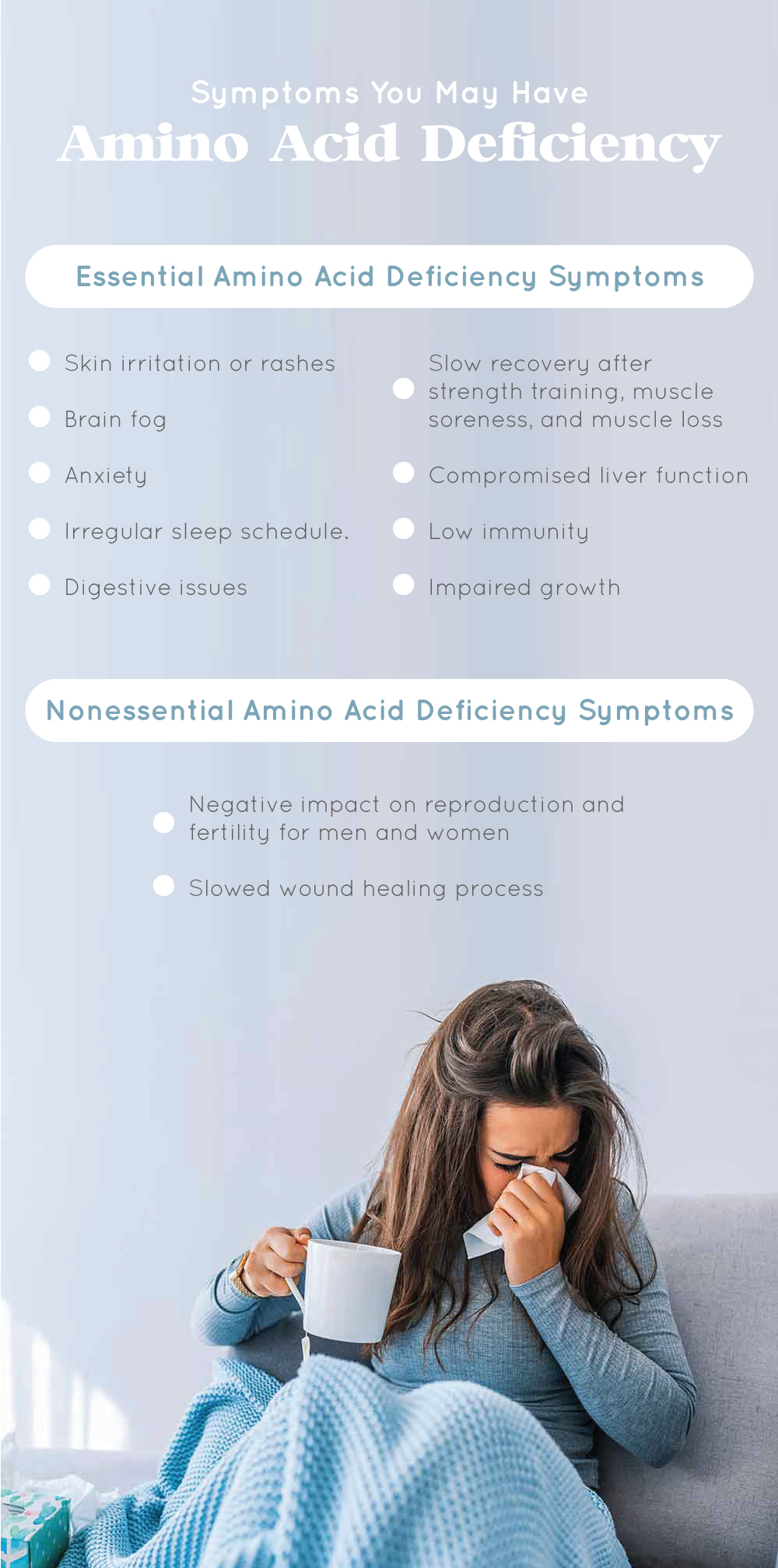
So You Think You May Have an Amino Acid Deficiency: What Are the Next Steps?
If you are exhibiting the signs of amino acid deficiency, it’s a good idea to check in with your doctor. He or she will be able to rule out any confounding factors that may be causing your symptoms and administer an amino acid deficiency test that pinpoints the missing amino acid. The next step is to identify the cause of the deficiency and adjust your diet accordingly.
Causes of Amino Acid Deficiencies
Nutritional imbalances or the presence of an underlying disease can impact amino acid metabolism and synthesis and lead to deficiencies.
Deficiency Due to Lack of Dietary Protein
Amino acids are present in protein-rich foods, and if your protein intake is not high enough, you’re at a higher risk for an amino acid deficiency. Additionally, under conditions like illness, injury, or stress, your body may require and utilize more amino acids than you are consuming and synthesizing. Older adults face an increased risk of inadequate food intake and associated protein deficits.
In any case, you should make sure that your dietary intake of amino acids is higher than usual. The key to counteracting amino acid deficits is to consume high-quality foods that contain bioavailable, digestible proteins with ideal ratios of amino acids. Examples of these foods are proteins found in eggs, milk, beef, soy protein, nuts, whole grains, and vegetables. In cases of severe deficiency, an amino acid supplement with optimal ratios of amino acids can help to quickly replenish amino acid deficits.
The Myth Surrounding a Vegan Diet and Protein Intake
A prevalent misconception people often hold is the idea that for a vegan, amino acid deficiency is more likely or even common. However, this is not the case! This misconstrued idea arises from the fact that in isolation, comparing a specific animal protein source like beef to a particular plant protein source like peanuts will reveal that the animal protein will almost always have a complete amino acid profile. On the other hand, with the exception of soy, any one plant protein source does not provide all necessary amino acids for biological functions. However, how many vegans consume just one source of protein throughout the day? A balanced vegan diet rich in fruits, vegetables, whole grains, nuts, beans, and other products like soy will provide a complete amino acid profile.
It’s also important to note that fresh fruits, vegetables, and whole grains provide additional benefits that animal protein products can’t, such as antioxidant and anti-inflammatory properties. Animal protein sources tend to also be higher in harmful compounds like cholesterol and saturated fat. (7)
Deficiency Due to Disease or Illness
A variety of conditions can contribute to deficits in amino acids. Genetic amino acid deficiency disorders are usually diagnosed early in life and impact the synthesis and metabolism of specific amino acids. For example, individuals with phenylketonuria are unable to properly metabolize phenylalanine, which results in dangerously high plasma levels of phenylalanine. A common intervention is to reduce nearly all dietary sources of phenylalanine – however, this often leads to symptoms of deficiency like fatigue, vomiting, and skin rashes.
Liver diseases like fatty liver disease or liver cirrhosis often results in amino acid imbalances, including particularly low levels of branched-chain amino acids. This amino acid deficiency can lead to muscle wasting, and in severe cases, a build-up of neurotoxins in the blood.
Bacterial infections like tuberculosis and pyelonephritis increase the utilization of proteins and deplete your body of amino acids. Additionally, gastrointestinal effects of viral and bacterial infections may result in inadequate absorption of amino acids and signs of deficiency.
In cases of genetic amino acid deficiencies and illness-induced deficiencies, it’s best to first receive medical treatment for the underlying cause, and then make nutritional adjustments to compensate for deficits.
Amino Acids Are Critical for Overall Health
Having adequate amino acid levels is crucial to combatting illnesses efficiently, facilitating proper metabolic functioning, and making sure that you feel your best. If you’re showing signs of an amino acid deficiency, check with your doctor and nutritionist to ensure that your diet is providing all of the amino acids that you need.
